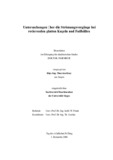Citation link:
https://nbn-resolving.org/urn:nbn:de:hbz:467-4041| Dokument Type: | Doctoral Thesis | metadata.dc.title: | Untersuchungen über die Strömungsvorgänge bei rotierenden glatten Kugeln und Fußbällen | Other Titles: | Investigations on the flow over rotating smooth spheres and soccer balls | Authors: | Kray, Thorsten | Institute: | Institut für Fluid- und Thermodynamik | Free keywords: | Magnuseffekt, Magnuskraft, Flattern, Flugkurve, Grenzschicht, sphere, soccer, flow, knuckling | Dewey Decimal Classification: | 620 Ingenieurwissenschaften und Maschinenbau | GHBS-Clases: | WDI | Issue Date: | 2008 | Publish Date: | 2009 | Abstract: | Die Wechselwirkung zwischen kugelförmigen Körpern und der sie umgebenden Strömung ist bei Ballsportarten von großer Bedeutung. Im Fußballsport werden Torschüsse und Freistöße häufig ohne oder mit wenig Rotation ausgeführt, um eine flatternde Flugbahn zu erhalten. In vielen Spielsituationen wird zudem der so genannte Magnuseffekt zur Erzeugung einer gekrümmten Flugkurve ausgenutzt. Ziel der vorliegenden Arbeit ist es, mit Hilfe einer Literaturstudie zunächst ein grundlegendes Verständnis der auftretenden Strömungsphänomene zu erhalten und aufzuzeigen, wo Forschungsbedarf besteht. Gleichzeitig wird herausgestellt, dass die verwendete Modellhalterung bei ein und demselben Experiment zur Kugelumströmung großen Einfluss auf die Ergebnisse ausübt. Bei der Konzeption der Windkanalversuchsstände dieser Arbeit lag das Hauptaugenmerk deshalb darauf, eine größtmögliche Reduktion der Interferenz zwischen der Umströmung der Modellhalterung und der Kugel- bzw. Ballumströmung mittels geeigneter konstruktiver Maßnahmen zu erreichen. Untersuchungen ohne Rotation zeigen, dass bei Fußbällen der kritische Reynolds-Zahl-Bereich verglichen mit glatten Kugeln zu deutlich niedrigeren Reynolds-Zahlen verschoben ist. Gleichzeitig treten in diesem kritischen Reynolds-Zahl-Bereich sehr hohe Auftriebs- und Seitenkräfte auf. Bei glatten Kugeln liegen im überkritischen Re- Bereich zeitlich gemittelte Auftriebs- und Seitenkräfte ungleich null vor, da der Nachlauf zu der strömungsparallelen Achse geneigt ist. Bei Fußbällen hängen im kritischen und überkritischen Re-Bereich Größe und Richtung der Kräfte quer zur Strömungsrichtung von der Ballausrichtung zur Anströmung ab. Die Untersuchungen mit Rotation zeigen: Die Messergebnisse der an den Polen angetriebenen glatten Kugeln und Modellfußbälle sind sehr stark durch den Einfluss der Aufhängung beeinflusst. Ergebnisse mit einer Aufhängung, welche die rotierenden Versuchskörper rückwärtig hält, weisen eine deutlich geringere Beeinflussung auf. Aerosol-Visualisierungen und Windkanalwaage-Messungen an der rotierenden Kugel zeigen, dass für Reynolds-Zahlen 125.000 The interaction of spherical bodies with the flow surrounding them plays a very important role in ball aerodynamics. In soccer shots on goal and free kicks are often performed without or with little spin in order to generate a swerve from the expected trajectory, the so-called knuckling effect. A second strategy involves applying spin to the ball around an axis perpendicular to the flight direction, which generates a curved trajectory due to the Magnus force. In the present study a basic understanding of the flow phenomena observed is established. Furthermore it is pointed out where more research on sphere and ball aerodynamics is needed. Additionally it is made clear, that experimental results often vary to a great extent even if the boundary conditions are the same due to the experimental set-up. Thus, the conceptual design of the wind tunnel set-ups of the present work was to reduce the flow interference of the supporting device with the sphere or soccer ball. Investigations in the non-rotating state show that for soccer balls the critical Reynolds number range is shifted to considerably lower Reynolds numbers than for a smooth sphere. Simultaneously very high lateral forces are observed in this critical Reynolds number range. For a smooth sphere in the supercritical Reynolds number range, lateral forces are non-zero when averaged over an appropriate time interval. The reason is that the wake is inclined with respect to the flow axis. In the supercritical Reynolds number regime of a soccer ball the magnitude and direction of the lateral forces depend on the ball orientation relative to the approaching flow. The investigations in the rotating state show the following: The results obtained on a sphere driven by a shaft passed through the sphere center are influenced to a great extent by the flow interaction with the supporting device. When a rear mounted supporting device is used, the results are less affected. Aerosol visualizations and wind tunnel balance measurements show that for a rotating sphere mainly reverse Magnus effect occurs when the Reynolds number is in a range of 125.000 to 450.000 and the spin parameter is based on rotational frequencies lower than 10 [Hz]. Considerable lateral forces and lateral force fluctuations occurring simultaneously prove that the Magnus effect for a sphere in the critical Reynolds number range is three-dimensional. For a model of a soccer ball a general shift of the Reynolds number range to lower Reynolds numbers is observed. Reverse Magnus effect occurs in a Reynolds number range of 96.000 to 248.000 whereas lateral forces are low. Soccer ball trajectory simulations without spin show that lateral forces do not significantly change the flight time, but cause a scattering of the coordinates in the goal plane. The reverse Magnus effect obtained on smooth spheres leads to lateral deviations from a straight trajectory opposite to those observed for soccer balls. |
URN: | urn:nbn:de:hbz:467-4041 | URI: | https://dspace.ub.uni-siegen.de/handle/ubsi/404 | License: | https://dspace.ub.uni-siegen.de/static/license.txt |
| Appears in Collections: | Hochschulschriften |
This item is protected by original copyright |
Page view(s)
599
checked on Apr 3, 2025
Download(s)
1,142
checked on Apr 3, 2025
Google ScholarTM
Check
Items in DSpace are protected by copyright, with all rights reserved, unless otherwise indicated.


